1. Introduction
 Apacer was founded in 1997. Two years later, it was ranked as the fourth-largest third-party manufacturer in the highly competitive global memory module market. Apacer's product line consists of memory modules and flash cards. Apacer is now a global digital storage provider offering a complete range of digital imaging storage devices.
Apacer was founded in 1997. Two years later, it was ranked as the fourth-largest third-party manufacturer in the highly competitive global memory module market. Apacer's product line consists of memory modules and flash cards. Apacer is now a global digital storage provider offering a complete range of digital imaging storage devices.
In a previous review, we had tested Apacer's DDR2 PC4300 CL4 memory modules. This time round, we received something a bit faster, two 512MB DDR2 PC5300 modules, capable of running at 667MHz.



Apacer uses Elpida's memory chipsets in its Memory modules.
• JEDEC standard 1.8V ± 0.1V Power Supply
• VDDQ = 1.8V ± 0.1V
• 4 Bank
• Posted CAS
• Programmable CAS Latency: 3, 4, 5
• Programmable Additive Latency: 0, 1 , 2 , 3 and 4
• Write Latency(WL) = Read Latency(RL) -1
• Burst Length: 4 , 8(Interleave/nibble sequential)
• Programmable Sequential / Interleave Burst Mode
• Bi-directional Differential Data-Strobe (Single-ended data-strobe is an optional feature)
• Off-Chip Driver(OCD) Impedance Adjustment
• On Die Termination
• Refresh and Self Refresh, Average Refresh Period 7.8us
• Serial presence detect with EEPROM
• DDR2 SDRAM Package: 60ball FBGA - 64Mx8
2. Test Configuration & System
After installing the Apacer PC5300 2X512MB memory modules in our test system as dual channel, we ran CPU-Z in order to see how they were identified by WinXP (SP2).

The first tests were done at 533Mhz with 4-4-4-11 timings, a setting which is automatically provided by the SPD. Below you can see further details for the memory and the CPU:
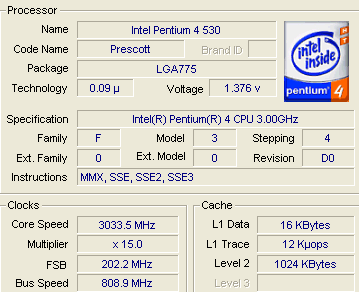
The next step was to set the memory to run at 667MHz, with the same timings. For this we had to increase the FSB from 200 up to 250. The configuration is given below.

Finally, we tried to find the highest limit for the memory. Above 674MHz, the memory either generated Memtest86+ errors or froze the system. We tried different timings, such as 5-5-5-15 but to no avail. The voltage during the tests was set at 2.2V. Since 674MHz is close enough to 667MHz, we considered it pointless to repeat all the tests for such a small gain.
In the following pages we will be comparing the performance of the Apacer memory to that of the OCZ PC5300. As you'll see, both memories report similar performance with the same configuration, at 533MHz and 667MHz. What makes the difference however, is that the OCZ modules are capable of running at 698MHz with 4-4-4-8 timings, while the CPU speed reached the amazing 3.93GHz with the FSB set at 262.

OCZ


Here's a rundown of our testbed:
System Specifications
CPU: Intel Pentium 4 3.00Ghz 530
Cooler: Arctic Cooling Freezer 7
Case: Antec
Motherboard: Asus P5AD2-E Premium
Power supply: CoolerMaster 450W
Memory: Apacer, OCZ PC5300 (dual channel)
VGA: Aopen Aeolus 6800Ultra PCI-E
Hard Disk Drive: WD800JD 80GB 7200RPM
OS: Windows XP Pro SP2
Drivers: 7.1.8.4
DirectX: v9.0c
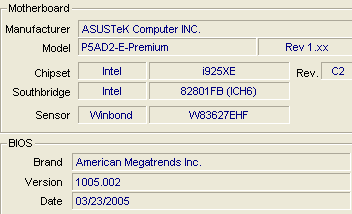

Benchmarks & Applications used
- Memtest86+-1.60
- Sisoft Sandra 2005
- PcMark04
- Performance Test V5.0 ( PassMark)
- Half Life 2 - VST
- CPU-Z v1.29
3. SiSoft Sandra 2005
 SiSoftware Sandra is a 32 and 64-bit Windows system analyser that includes benchmarking, testing and listing modules. It tries to go beyond other utilities to show you more of what is really going on under the hood so you draw comparisons at both a high and low-level in a single product.
SiSoftware Sandra is a 32 and 64-bit Windows system analyser that includes benchmarking, testing and listing modules. It tries to go beyond other utilities to show you more of what is really going on under the hood so you draw comparisons at both a high and low-level in a single product.
You can get information about the CPU, chipset, video adapter, ports, printers, sound card, memory, network, Windows internals, AGP, ODBC Connections, USB2, Firewire etc.
You can save/print/fax/e-mail/post/upload or insert into ADO/ODBC databases reports in text, HTML, XML, SMS/DMI or RPT format.
This version supports multiple sources of information gathering including: remote computers, PDAs, Smart Phones, ADO/ODBC databases or saved system reports.
All benchmarks are optimised for both SMP & SMT (Hyper-Threading), up to 32/64 CPUs depending on the platform.
Memory Bandwidth Benchmark
Tests how your memory sub-system compares to other systems with the same or similar memory in other systems. The benchmark is based on the well-known STREAM memory bandwidth benchmark.
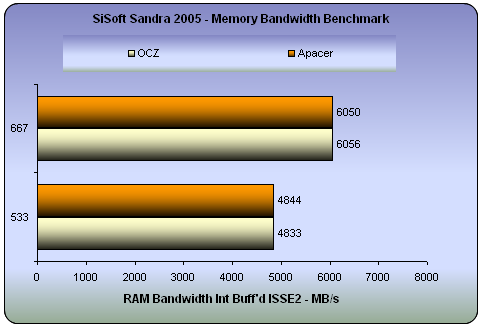
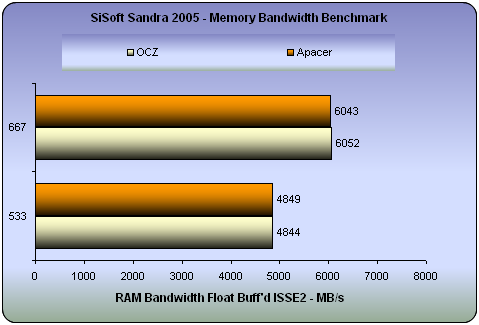
Cache & Memory Benchmark
Tests how your CPU cache and memory sub-system(s) compares to other systems with the same or similar CPU & memory in other systems. The benchmark is based on the Memory Bandwidth Benchmark test.
Combined Index: is a composite figure representing the overall performance rating of the entire Cache-Memory performance in terms of MB/s. The value is the logarithmic average of all the results for the entire address space. (Higher is better, i.e. better performance)
For block sizes that could not been tested - the average of previous blocks is used, thus the size of the memory (as long as it is not comparable to largest cache size) is not significant; all cache sizes are significant - larger caches will result in a higher index.
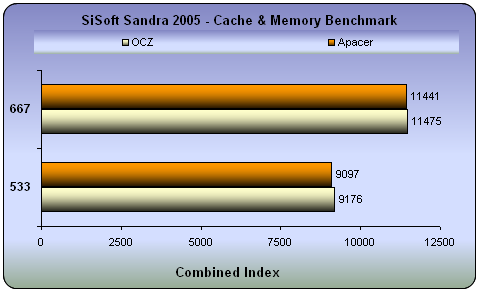
Speed Factor: is a figure representing the speed differential between the CPU’s cache and memory. The value is the ratio of the fastest cache (i.e. L1) bandwidth to the main memory bandwidth. (Lower is better, i.e. the memory is not very much slower than CPU’s cache)
As the factor is a ratio, it is useful only in comparing different CPUs and memory sub-systems rather than having a direct, physical interpretation associated to its numerical value.

OCZ reported better performance, but still the differences are negligible. Overall, we believe that both memory sets performed equally well.
4. PCMark05
 PCMark05 is an application-based benchmark and a premium tool for measuring overall PC performance. It uses portions of real applications instead of including very large applications or using specifically created code. This allows PCMark05 to be a smaller installation as well as to report very accurate results. As far as possible, PCMark05 uses public domain applications whose source code can be freely examined by any user.
PCMark05 is an application-based benchmark and a premium tool for measuring overall PC performance. It uses portions of real applications instead of including very large applications or using specifically created code. This allows PCMark05 to be a smaller installation as well as to report very accurate results. As far as possible, PCMark05 uses public domain applications whose source code can be freely examined by any user.
PCMark05 includes 4 categorized suites for benchmarking your computer. These include CPU, Graphics, Memory and a Hard Disk Drive benchmark. In our case, we selected to run only the Memory test suite.
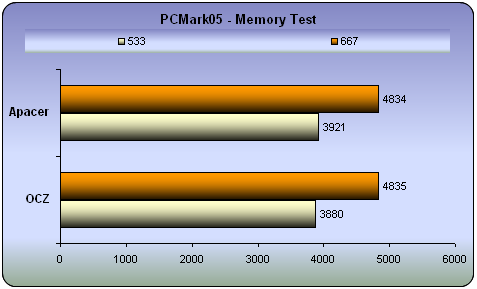
According to PCMark's total score, the Apacer modules were a little faster at 533MHz while at 667MHz, both memories reported nearly identical performance.
| PCMark05 Memory Test |
533 |
667 |
| Apacer |
OCZ |
Apacer |
OCZ |
| Memory Read 16MB |
5946.440 |
5942.129 |
7403.193 |
7393.917 |
| Memory Read 8MB |
6152.767 |
6075.894 |
7565.006 |
7484.313 |
| Memory Read 192KB |
23823.557 |
23509.307 |
29489.004 |
29406.596 |
| Memory Read 4KB |
39831.461 |
39413.406 |
49165.918 |
49232.141 |
| Memory Write 16MB |
4078.053 |
4041.224 |
5028.575 |
5034.631 |
| Memory Write 8MB |
4075.689 |
4037.552 |
5033.399 |
5054.330 |
| Memory Write 192KB |
10208.533 |
10101.730 |
12572.449 |
12603.071 |
| Memory Write 4KB |
10252.685 |
10153.104 |
12640.302 |
12694.492 |
| Memory Copy 16MB |
4341.146 |
4242.949 |
5246.027 |
5262.867 |
| Memory Copy 8MB |
4318.229 |
4230.733 |
5279.252 |
5271.270 |
| Memory Copy 192KB |
8997.681 |
8922.591 |
11145.869 |
11145.202 |
| Memory Copy 4KB |
10248.381 |
10157.710 |
12663.648 |
12674.995 |
| Memory Latency 16MB |
7.767 |
7.695 |
9.527 |
9.569 |
| Memory Latency 8MB |
8.068 |
8.052 |
9.995 |
9.992 |
| Memory Latency 192KB |
129.529 |
128.276 |
159.961 |
159.962 |
| Memory Latency 4KB |
757.882 |
752.150 |
938.048 |
938.043 |
5. Performance Test v5.0
 Passmark PerformanceTest is an award winning PC hardware benchmark utility that allows anyone to quickly assess the performance of their computer and compare it to a number of standard 'baseline' computer systems.
Passmark PerformanceTest is an award winning PC hardware benchmark utility that allows anyone to quickly assess the performance of their computer and compare it to a number of standard 'baseline' computer systems.
Twenty seven standard benchmark tests are available in seven test suites plus, there are five advanced testing windows for custom benchmarking. CPU Tests, 2D Graphics Tests, 3D Graphics Tests, Disk Tests, Memory Tests and CD/DVD Tests. In our case, we selected the Memory suite Tests.
- Memory Benchmarks
This suite contains a number of tests that exercise the memory sub-system of the computer. (Random Access Memory- RAM)
Memory - Allocate small block
This test measures the time taken to allocate & free small zeroed memory blocks (around 100KB block size)
Memory - Cached
This test measures the time taken to read a small block of memory. The block is small enough to be held entirely in cache (if one is present)
Memory - UnCached
This test measures the time taken to read a large block of memory. The block is too large to be held in cache.
Memory - Write
This test measures the time taken to write information into memory.
Just for comparison reasons, below is the performance of the OCZ memory for the same task:
Both tested memories performed almost identically. While you may notice some differences, where OCZ is better in some tests while Apacer in others, the differences are negligible. Overall, the performance is similar for both.
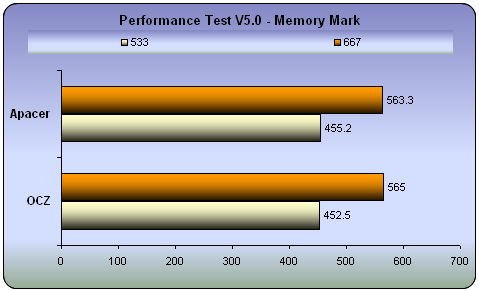
- Advanced Memory Benchmark
Memory Speed Per Access Step Size
The first test type, ‘Memory Speed Per Access Step Size’ accesses a large block, of memory in various sized steps. First, it runs through the block of memory sequentially, accessing every value. Next it runs through the same block again, except this time it accesses every second value. On this occasion, it runs through the block twice in order to access the same amount of data as the initial step. Next it runs through the same block again, except this time it accesses every fourth value and so makes four passes. And so on, until a certain maximum step size is reached.
The size of the block of memory used for this test is one quarter the amount of system RAM. The size of the steps varies from 1 (continuous sequential access), to one quarter the size of the block of memory ( i.e. one sixteenth of the system RAM ).
| Memory Speed (MB/Sec. per Step Size) |
533MHz
(MB/s) |
667MHz
(MB/s) |
| Apacer |
| Block Read Speed |
30.51 |
37.59 |
| Block Write Speed |
21.11 |
26.41 |
| OCZ |
| Block Read Speed |
30.10 |
37.56 |
| Block Write Speed |
21.44 |
26.47 |
Memory Speed Per Block Size
When a computer program wants to use a section of memory to store data, it makes a request to Windows for the amount of memory it requires. Windows allocates the memory to the program ( unless system resources are very low ) and returns to the requesting program the address of the first memory slot in the allocated block. It is possible that some programs may request very large amounts of memory. The ‘Memory Speed Per Block Size’ test like the ‘Memory Speed Per Access Step Size’ test, is composed of many steps. During each step of the test, PerformanceTest requests a block of memory and runs through the block measuring the average access time. However on each subsequent step the size of the requested memory is increased, until finally a block close to the size of the system RAM is requested. In this way it is possible to observe the different access speeds for the different sizes of blocks.
Typically it is possible to see very fast memory access for blocks which are small enough to fit entirely into the L2 RAM cache, and slower access times for larger blocks accessed from main RAM. In the case where system resources are low, swapping to the disk may even be required for very large blocks.
| Memory Speed (MB/Sec. per Block Size) |
533MHz
(MB/s) |
667MHz
(MB/s) |
| Apacer |
| Block Read Speed |
345.36 |
427.13 |
| Block Write Speed |
240.47 |
297.17 |
| OCZ |
| Block Read Speed |
342.35 |
427.92 |
| Block Write Speed |
238.47 |
297.51 |
Again, the performance for both memory sets in the advanced tests was similar.
6. Half Life 2
 Half life 2 is no doubt the most anticipated pc game of all times. Gamers having the excellence of Half Life 1 in mind, as well as the remarkable E3 demo preview, have been anxiously waiting for the much delayed release of HL2.
Half life 2 is no doubt the most anticipated pc game of all times. Gamers having the excellence of Half Life 1 in mind, as well as the remarkable E3 demo preview, have been anxiously waiting for the much delayed release of HL2.
Physics - From pebbles to water to 2-ton trucks respond as expected, as they obey the laws of mass, friction, gravity, and buoyancy.
Graphics - Source's shader-based renderer, like the one used at Pixar to create movies such as Toy Story® and Monster's, Inc.®, creates the most beautiful and realistic environments ever seen in a video game.
AI - Neither friends nor enemies charge blindly into the fray. They can assess threats, navigate tricky terrain, and fashion weapons from whatever is at hand.
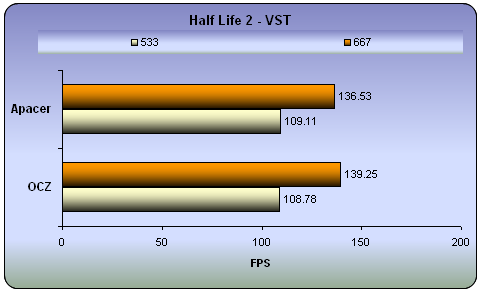
With games, the increased FSB in combination with the memory speed, boosted performance. Once again, there shouldn't be a great difference, no matter which memory brand you choose between. If you run the VST test more than once, you'll notice a deviation in the results of 1~2% which is to be expected.
7. Conclusion
 The Apacer memory modules we tested, produced very good overall performance. At 533MHz and 667MHz, the modules are comparable in performance to OCZ's PC5300.
The Apacer memory modules we tested, produced very good overall performance. At 533MHz and 667MHz, the modules are comparable in performance to OCZ's PC5300.
According to our tests, Apacer's memory modules proved to be about equal to the OCZ PC5300 modules we have reviewed in the past, but any differences were negligible.
With SiSoftware Sandra 2005, OCZ showed marginally better performance while with PCMark05, the honours were divided. PassMark reported slightly better results for the OCZ modules while in Half Life 2, the performance was the same for both memory sets.
Don't expect performance above 667MHz. To be honest, going on past experience with the previous Apacer memory we tested, where the certified 533MHz PC4300 modules could run at 690MHz, we expected to see something better than 674MHz. Above this frequency, Memtest86+ reported either errors or our test PC froze.

On the e-market, it is not to easy to locate Apacer's memory modules, something we also highlighted in our previous Apacer memory review. Prices are around $210 in the US and close to €185 in the Europe, including VAT for Apacer 2X512MB DDR2 PC5300 667MHz modules.